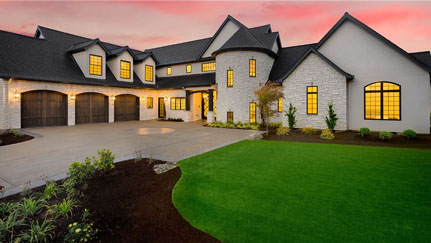
You’ve purchased the perfect piece of land and found a trusted architect to design your dream home. Although the property happens to be in a wildfire-prone area, your new home can be a safe haven with smart design and building solutions.
Here are some ways you can build a home that’s designed to survive a wildfire:
Site layout
- When choosing a property, consider the lot topography — steeper slopes can put your property at higher risk1
- Discuss the possibility of wildfires with your builder and position the home in a way that limits your risk, including hardscaping the perimeter
- Clear vegetation, including all dry grass, brush, trees and dead leaves, within at least 100 feet of your home and other structures on your property to ensure your property has “defensible space”2
- Be sure the driveway is wide enough for firetrucks to gain access
Landscaping
- Integrate materials such as crushed stone, gravel and river rock into your landscaping, particularly in areas directly around the structure for extra protection; never use wood chips
- Ensure that all landscaped areas are properly covered by your irrigation system
- Discuss preventive maintenance with your landscaping service to make sure all dry vegetation is regularly removed; consider appropriate spacing between vegetation to prevent the spread of fire, and make sure to trim tree branches to reduce ladder fuels
Fire-resistant construction
Using materials that have a low potential for combustion is one of the most critical elements in constructing your home.
- Walls: Stone, brick, steel, concrete and masonry have the highest fire ratings.3 Structural concrete insulated panels (SCIP) coated with fire-resistant structural cement is a modern option that has a Class A fireproof rating, is noncombustible and withstands extremely high temperatures. It can also be used for roofs.4
- Roofs: Use materials that are resistant to ignition, such as metal, slate, composition shingles, flat concrete or clay tile.4 Barrel tiles have gaps that can trap embers. A steeper pitch is better than a flat one, and installing a sprinkler system on the roof can help slow a fire.5
- Vents and overhangs: Attic vents, roof and gable end vents, roof overhangs and under-eave areas are entry points for embers and flames. You can reduce risk by covering vents with a 1/8-inch metal mesh screen and boxing in hazardous eaves with stucco.5
- Windows and frames: Windows are vulnerable from the heat even before the flames draw near. Steel-clad window frames with fire-resistant double pane or triple pane glass offer the most protection, while nonflammable shutters can be added for further defense. If skylights are desired, use specialized glass.6
- Decks: Outdoor living spaces are particularly vulnerable due to windblown embers. When building, use noncombustible, Class A fireproof-rated building materials such as composite decking board or SCIP. Be sure all vegetation is removed from underneath the deck.7 Make sure to stack woodpiles away from the deck.
- Chimney: An uncapped chimney may allow firebrands to enter a structure and ignite flammable materials. This risk can be mitigated by installing a spark arrestor made from welded wire or woven wire mesh with openings less than 1/8-inch wide at the top of the chimney.
- Fencing: Use noncombustible materials, such as masonry, stone or metal, for perimeter fencing.
With smart planning, you can design your dream home with fireproof building materials to help lower your risk of loss from wildfires. Talk to your Nationwide Private Client agent about more wildfire damage prevention resources.
[1] “How To Build Fire-Proof Homes,” Matthew Power, builderonline.com/building/safety-healthfulness/how-to-build-fire-proof-homes_o (Apr. 29, 2003).
[2] Wildfire Defense Systems.
[3] “The New Fire Safe Building Design,” Dilip Khatri and Gina Keil Cruz for STRUCTURE magazine, structuremag.org/wp-content/uploads/2014/08/C-StructuralDesign-Khatri-Oct081.pdf (October 2008).
[4] FAQs, heftyhomes.org/faq (2019).
[5] “Roofing Materials: Roofs are a highly vulnerable part of a home during wildfires,” firesafemarin.org/?option=com_fileman&view=file&routed=1&name=FactSheetsRoofingMaterialsFSM.pdf&folder=resources&container=fileman-files (2017).
[6] “Fire-Safe Building Materials,” homeguides.sfgate.com/firesafe-building-materials-55515.html (accessed Sept. 22, 2019).
[7] “Fire Resistant Green Building,” adapted for the web from “When Technology Fails: A Manual for Self-Reliance, Sustainability, and Surviving the Long Emergency,” Matthew Stein, chelseagreen.com/2009/fire-resistant-green-building (Aug. 18, 2018).
This overview is for informational purposes only and does not replace or modify the definitions and information contained in individual insurance policies, their endorsements or declarations pages, which are controlling. Terms and availability vary by state and exclusions apply. Products are underwritten by Nationwide Mutual Insurance Company and affiliated companies, including Crestbrook Insurance, Columbus, Ohio. Nationwide, the Nationwide N and Eagle, Nationwide is on your side and Nationwide Private Client are service marks of Nationwide Mutual Insurance Company.
[2] Wildfire Defense Systems.
[3] “The New Fire Safe Building Design,” Dilip Khatri and Gina Keil Cruz for STRUCTURE magazine, structuremag.org/wp-content/uploads/2014/08/C-StructuralDesign-Khatri-Oct081.pdf (October 2008).
[4] FAQs, heftyhomes.org/faq (2019).
[5] “Roofing Materials: Roofs are a highly vulnerable part of a home during wildfires,” firesafemarin.org/?option=com_fileman&view=file&routed=1&name=FactSheetsRoofingMaterialsFSM.pdf&folder=resources&container=fileman-files (2017).
[6] “Fire-Safe Building Materials,” homeguides.sfgate.com/firesafe-building-materials-55515.html (accessed Sept. 22, 2019).
[7] “Fire Resistant Green Building,” adapted for the web from “When Technology Fails: A Manual for Self-Reliance, Sustainability, and Surviving the Long Emergency,” Matthew Stein, chelseagreen.com/2009/fire-resistant-green-building (Aug. 18, 2018).
This overview is for informational purposes only and does not replace or modify the definitions and information contained in individual insurance policies, their endorsements or declarations pages, which are controlling. Terms and availability vary by state and exclusions apply. Products are underwritten by Nationwide Mutual Insurance Company and affiliated companies, including Crestbrook Insurance, Columbus, Ohio. Nationwide, the Nationwide N and Eagle, Nationwide is on your side and Nationwide Private Client are service marks of Nationwide Mutual Insurance Company.